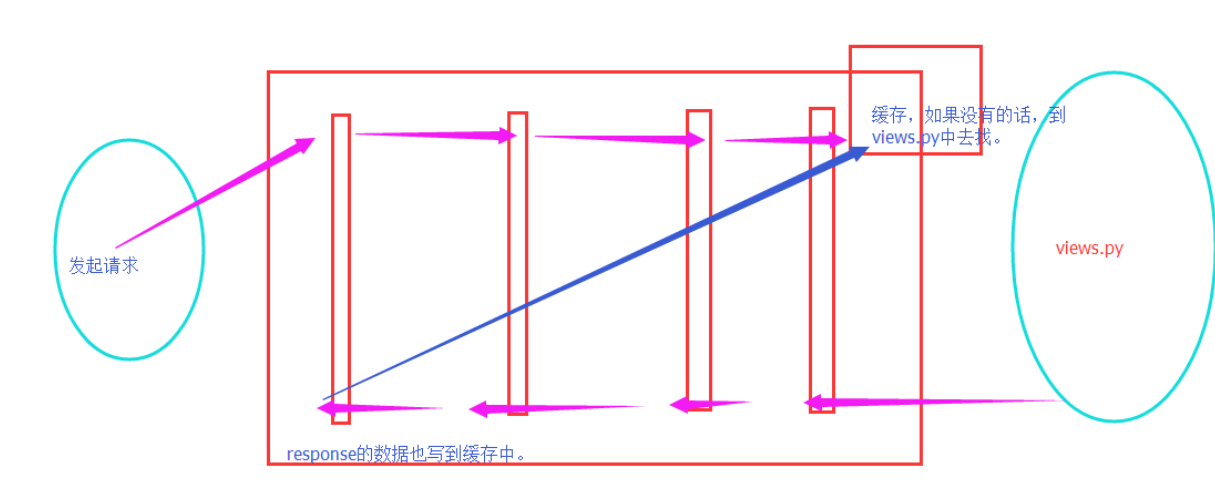由于Django是动态网站,所有每次请求均会去数据进行相应的操作,当程序访问量大时,耗时必然会更加明显,最简单解决方式是使用:
缓存,缓存将一个某个views的返回值保存至内存或者memcache中,5分钟内再有人来访问时,则不再去执行view中的操作,而是直接从内存或者Redis中之前缓存的内容拿到,并返回。
Django中提供了6种缓存方式:
- 开发调试----什么都不做
- 内存
- 文件-----放到文件中
- 数据库------放到数据库中
- Memcache缓存(python-memcached模块)------memcache是一套分布式的高速缓存系统
- Memcache缓存(pylibmc模块)---------memcache是一套分布式的高速缓存系统,用这个pylibmc模块去连接远程的Memcache机器。
3种应用
全局的
视图函数
局部模板
开发调试,caches:高速缓存的意思。
1 # 此为开始调试用,实际内部不做任何操作 2 # 配置: 3 CACHES = { 4 'default': { 5 'BACKEND': 'django.core.cache.backends.dummy.DummyCache', # 引擎 6 'TIMEOUT': 300, # 缓存超时时间(默认300,None表示永不过期,0表示立即过期) 7 'OPTIONS':{ 8 'MAX_ENTRIES': 300, # 最大缓存个数(默认300) 9 'CULL_FREQUENCY': 3, # 缓存到达最大个数之后,剔除缓存个数的比例,即:1/CULL_FREQUENCY(默认3),剔除1/3 10 }, 11 'KEY_PREFIX': '', # 缓存key的前缀(默认空) 12 'VERSION': 1, # 缓存key的版本(默认1) 13 'KEY_FUNCTION' 函数名 # 生成key的函数(默认函数会生成为:【前缀:版本:key】) 14 } 15 } 16 17 18 # 自定义key 19 def default_key_func(key, key_prefix, version): 20 """ 21 Default function to generate keys. 22 23 Constructs the key used by all other methods. By default it prepends 24 the `key_prefix'. KEY_FUNCTION can be used to specify an alternate 25 function with custom key making behavior. 26 """ 27 return '%s:%s:%s' % (key_prefix, version, key) 28 29 def get_key_func(key_func): 30 """ 31 Function to decide which key function to use. 32 33 Defaults to ``default_key_func``. 34 """ 35 if key_func is not None: 36 if callable(key_func): 37 return key_func 38 else: 39 return import_string(key_func) 40 return default_key_func
2:,缓存将内容保存至内存的变量中
1 # 此缓存将内容保存至内存的变量中 2 # 配置: 3 CACHES = { 4 'default': { 5 'BACKEND': 'django.core.cache.backends.locmem.LocMemCache', 6 'LOCATION': 'unique-snowflake', 7 } 8 } 9 10 # 注:其他配置同开发调试版本
3,缓存将内容保存至文件
1 # 此缓存将内容保存至文件 2 # 配置: 3 4 CACHES = { 5 'default': { 6 'BACKEND': 'django.core.cache.backends.filebased.FileBasedCache', 7 'LOCATION': '/var/tmp/django_cache', 8 } 9 } 10 # 注:其他配置同开发调试版本
4,缓存将内容保存至数据库
1 # 此缓存将内容保存至数据库 2 3 # 配置: 4 CACHES = { 5 'default': { 6 'BACKEND': 'django.core.cache.backends.db.DatabaseCache', 7 'LOCATION': 'my_cache_table', # 数据库表 8 } 9 } 10 11 # 注:执行创建表命令 python manage.py createcachetable
5,缓存使用python-memcached模块连接memcache
1 # 此缓存使用python-memcached模块连接memcache 2 3 CACHES = { 4 'default': { 5 'BACKEND': 'django.core.cache.backends.memcached.MemcachedCache', 6 'LOCATION': '127.0.0.1:11211', 7 } 8 } 9 10 CACHES = { 11 'default': { 12 'BACKEND': 'django.core.cache.backends.memcached.MemcachedCache', 13 'LOCATION': 'unix:/tmp/memcached.sock', 14 } 15 } 16 17 CACHES = { 18 'default': { 19 'BACKEND': 'django.core.cache.backends.memcached.MemcachedCache', 20 'LOCATION': [ 21 '172.19.26.240:11211', 22 '172.19.26.242:11211', 23 ] 24 } 25 }<br><br> CACHES = {<br> 'default': {<br> 'BACKEND': 'django.core.cache.backends.memcached.MemcachedCache',<br> 'LOCATION': [<br> ('172.19.26.240:11211',1),<br> ('172.19.26.242:11211',15), 调权重<br> ]<br> }<br> }
6,缓存使用pylibmc模块连接memcache
1 # 此缓存使用pylibmc模块连接memcache 2 3 CACHES = { 4 'default': { 5 'BACKEND': 'django.core.cache.backends.memcached.PyLibMCCache', 6 'LOCATION': '127.0.0.1:11211', 7 } 8 } 9 10 CACHES = { 11 'default': { 12 'BACKEND': 'django.core.cache.backends.memcached.PyLibMCCache', 13 'LOCATION': '/tmp/memcached.sock', 14 } 15 } 16 17 CACHES = { 18 'default': { 19 'BACKEND': 'django.core.cache.backends.memcached.PyLibMCCache', 20 'LOCATION': [ 21 '172.19.26.240:11211', 22 '172.19.26.242:11211', 23 ] 24 } 25 }
文件来做一个示例,即缓存内容保存到文件
在setting中配置缓存

1 # 此缓存将内容保存至文件 2 # 配置: 3 CACHES = { 4 'default': { 5 'BACKEND': 'django.core.cache.backends.filebased.FileBasedCache', 6 'LOCATION':os.path.join(BASE_DIR,'cache') 7 } 8 }
写cache视图函数

1 def cache(request): 2 import time 3 ctime = time.time() 4 return render(request,'cache.html',{'ctime':ctime})
写cache.html模板

1 <!DOCTYPE html> 2 <html lang="en"> 3 <head> 4 <meta charset="UTF-8"> 5 <title>Title</title> 6 </head> 7 <body> 8 <h1>{{ ctime }}</h1> 9 <h1>{{ ctime }}</h1> 10 <h1>{{ ctime }}</h1> 11 </body> 12 </html>
运行结果:每次刷新,时间都会发生变化
cache视图函数
给单独的views函数做上缓存,用装饰器实现。如果请求过来,先去缓存中去找,找不到的话,再执行函数。在这里设置了缓存为10秒钟有效,10秒之内刷页面,都是去缓存中拿数据,时间一直保持不变。10秒之后,时间才会更新。

1 from django.views.decorators.cache import cache_page 2 3 @cache_page(10) 4 def cache(request): 5 import time 6 ctime = time.time() 7 return render(request,'cache.html',{'ctime':ctime})
运行效果:10秒以后,时间才会发生变化。而且发现cache下的文件里面也有了缓存数据
模板的某个局部做缓存

1 {% load cache %} 2 <!DOCTYPE html> 3 <html lang="en"> 4 <head> 5 <meta charset="UTF-8"> 6 <title>Title</title> 7 </head> 8 <body> 9 <h1>{{ ctime }}</h1> 10 <h1>{{ ctime }}</h1> 11 {% cache 10 cuuuu %} 12 <h1>{{ ctime }}</h1> 13 {% endcache %} 14 </body> 15 </html>
全栈(全局)缓存,对整个网站的函数都做缓存
用中间件实现,所有请求都经过中间件。
在返回的最后一步才写到缓存中,因为在通过中间件的过程中,是可以修改views.py中的内容的。所以写到缓存中的应该是最终的版本。

说明:

实例:
'django.middleware.cache.UpdateCacheMiddleware', 它里面没有process-request,只有process-response,只有离开的时候才会执行一次它,临走的时候更新一下。
'django.middleware.cache.FetchFromCacheMiddleware', 它里面只有process_view,只有来的时候执行它,走的时候跟它没有关系。
用户请求第一次来的时候,先到达中间件,跳过'django.middleware.cache.UpdateCacheMiddleware',一直往下执行,直到'django.middleware.cache.FetchFromCacheMiddleware',
到它以后去缓存中找数据,如果没有的话,则继续往下到views.py中去找。
返回数据时,跳过'django.middleware.cache.FetchFromCacheMiddleware',直到'django.middleware.cache.UpdateCacheMiddleware',把数据返回给用户,同时把数据放到缓存中。
第二次请求到来的时候,到达到'django.middleware.cache.FetchFromCacheMiddleware',去缓存中找数据,发现有数据,则不用去views.py中取数据了,一直返回给客户。
